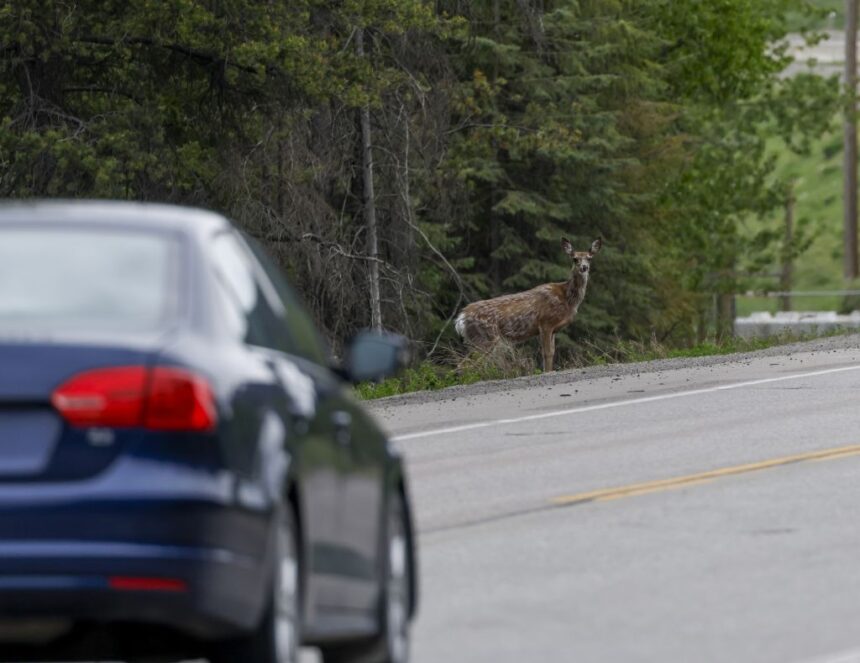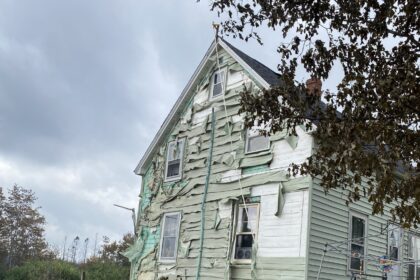At least 12,959 wild animals died on B.C. roads and highways between January 2023 and May 2025 — thousands of deer, hundreds of bears and coyotes, dozens of beavers and skunks killed in collisions.That’s only the fraction of animals killed by vehicles captured in the provincial wildlife accident-reporting system. Animals that fled the roadside before succumbing to their injuries and scores of amphibians crushed by passing cars often aren’t counted, meaning the true toll is likely much greater.Roads and highways are a problem for wildlife across the country and around the world: snapping turtles are regularly killed in Ontario, as are mountain lions in California and kangaroos in Australia. And it’s not just wildlife at risk when cars hit animals. People can be seriously injured or killed, too. These collisions can also be expensive. In B.C. they can cost about $40 million in insurance claims alone each year, according to estimates from Insurance Corporation of British Columbia (ICBC) based on data from 2009-2013. A spokesperson for ICBC said they could not provide updated data by publication time.A new wildlife overpass on Highway 93 near Radium Hot Springs, B.C., is aimed at preventing collisions with bighorn sheep and other wildlife, like the fencing and crossings in Banff National Park.Governments in Canada and elsewhere have tried different measures to prevent collisions, including posting signs to warn drivers to look out for wildlife and testing wildlife detection systems to alert drivers when animals are on the road. But the gold standard so far is a combination of fencing and crossing structures — like those in Banff National Park.Banff “really taught us a lot,” says Clayton Lamb, a wildlife scientist with the research institute Biodiversity Pathways.About 82 kilometres of highway were fenced and 44 crossing structures constructed in the famed national park beginning in the 1980s, when the Trans-Canada Highway was expanded from two lanes to four through the park. The wildlife system cut collisions by more than 80 per cent, according to Parks Canada. While these systems are expensive to build — the Banff system cost tens of millions of dollars — they can save money in the long run. Fewer collisions means less money spent on health care and insurance payouts.In B.C.’s Rocky Mountains to the south, work is now underway on a project that aims to fence almost 30 kilometres of Highway 3 and retrofit a series of existing bridges to reduce collisions and give animals a safer way to cross the road. The project, called Reconnecting the Rockies, continues into neighbouring Alberta, where another 50 kilometres of fencing and crossing structures are partially complete. In this corridor alone, more than 300 collisions with large animals are reported each year.“This project is designed to mirror that success in Banff and bring it to Highway 3,” Lamb, the lead scientist for the B.C. side, explains.Crowsnest Highway endangers wildlife, restricts animal movementDriving the highway in early June, Lamb points out a blood splatter in the middle of the road and a bald eagle in the ditch, feeding on the remains of a whitetail deer likely hit that morning. It’s one of the insidious challenges of roadkill — when one animal is hit its carcass can attract another to the road, putting that animal in a risky spot as well.Highway 3, also known as the Crowsnest Highway, is the winding southern route across B.C., running from Hope through Osoyoos, Creston and Cranbrook all the way to Medicine Hat in Alberta.When an animal like a deer gets hit by a car, it can attract other animals such as bald eagles and bears to the roadside to feed, putting those animals at risk too.The Reconnecting the Rockies project zeroes in on an 80-kilometre stretch running from outside Hosmer, B.C., to Lundbreck, Alta. The hope is it will eventually extend through the rest of the Elk Valley as well.The Elk Valley is a complicated place. It’s home to a wide array of wildlife, like grizzly bears, elk, deer and bighorn sheep, and the habitats that support them. It also serves as a vital link between major protected areas like Banff to the north and Montana’s Glacier National Park to the south. At the same time, it’s home to several growing communities, mountain-top removal coal mines and a busy transportation corridor in Highway 3 and the railway, which trains carrying coal, grain and numerous other products travel every day.The highway is a challenge for a couple of reasons. It’s a barrier to animal movement, which can make it difficult for species to travel farther distances in search of food or mates, limiting a population’s gene pool and generally making an animal’s world smaller. More directly, animals are killed when they try to cross the road.Wildlife scientist Clayton Lamb monitors animal movement at retrofitted wildlife underpasses along Highway 3 using remote cameras. So far, it seems animals are using the crossings.Most collisions between Jaffray, B.C., and the Alberta border involve elk and deer, with roughly 90 elk and 50 deer hit each year, according to a Reconnecting the Rockies progress report for 2020 to 2024.“It doesn’t seem consistent with how we want to relate to wildlife that are iconic and important to many people,” Lamb says. “And from a hunting and cultural harvest and food security standpoint, it’s also a bunch of elk that are being wasted.”Jason Gravelle, the acting chief administrative officer for Yaq̓it ʔa·knuqⱡi’it, which is part of the Ktunaxa Nation, agrees.While not every member of his nation is reliant on locally harvested food, elk have become an important food source, he says, adding “We can’t head over the mountains to go hunt buffalo anymore.”With so many elk killed on the highway, the crossings project is “definitely needed,” he says. And it’s not just elk and deer at risk. A third of all reported grizzly bear collisions in B.C. happen in the Elk Valley, even though the area accounts for just one per cent of grizzly habitat in the province, according to Lamb’s research. For grizzlies in this region, it’s a leading cause of death.Choosing where to put wildlife crossingsReconnecting the Rockies is the result of a broad collaboration involving the B.C. and Alberta governments, Parks Canada, conservation groups, First Nations, scientists and Elk Valley Resources, which operates several coal mines in the area.In B.C., it broke ground in 2020. By the end of 2024, fencing had been installed along 4.2 kilometres of highway and six underpasses had been retrofitted to make it easier for wildlife to cross the busy road. So far, B.C.’s Ministry of Transportation and Transit says it has spent about $3.7 million on the project.There’s still a long way to go before the project as envisioned is complete, but monitoring shows wildlife is already using some of the upgraded underpasses more frequently.Mule deer and other animals are already using this upgraded underpass on Highway 3 in southeast B.C. Photos used to create gif: Supplied by Reconnecting the Rockies: BCLamb walks down a gentle slope next to the Loop highway bridge that spans Michel Creek, about 10 kilometres east of Sparwood.“This was just a wall of no access,” he says. The slope used to be steeper and it was almost entirely blocked off by old concrete footings and rebar.Today, there’s a wide, gentle lane that runs down to the creek and alongside it below the highway. “It’s a beautiful underpass,” Lamb says. “It’s super comfy and elk can tell that there’s not, like, a cougar waiting on the other side.”Another retrofit, at the Alexander Creek bridge, saw a path cleared through the protective wall of big, loose rocks that once angled sharply into the creek.In B.C., the project has so far focused on retrofitting existing road infrastructure to improve crossings. In large part because it’s the most cost-effective option, but it can also transform existing infrastructure into great wildlife crossings.The Loop bridge underpass would have cost millions to build from scratch, Lamb said. Retrofitting the existing highway bridge over the creek meant creating an “amazing” wildlife underpass for a fraction of the cost.But not every effort has been a success. Even with fencing and a new trail beneath the bridge, the Carbon Creek underpass is far from ideal, Lamb says. There’s not much clearance between the bridge and the creekside path and there’s poorer visibility than at more spacious underpasses. Wildlife only uses it occasionally.Gravelle said Yaq̓it ʔa·knuqⱡi’it cautioned the Reconnecting the Rockies team to do its homework before choosing crossing sites. They should be selected based on how wildlife uses the area, not what’s cheapest from an engineering perspective, he said.“That’s something you always have to be careful of — they can look really good as dots on the map, but are they functionally big enough?” Lamb says.Wildlife scientist Clayton Lamb says the upgraded Loop bridge underpass would have cost millions to build from scratch. Instead they retrofitted existing infrastructure at only a fraction of the cost of a new build.The recently completed Rock Creek underpass on Highway 3, is on the Alberta side of the Reconnecting the Rockies project corridor, about 40 kilometres east of the B.C. border.Other existing underpasses were better suited to retrofits, especially those already proving useful. “We’ve had remote cameras under a lot of these structures before anything has been done to them and there are already animals using them even without fencing or any improvements on our end,” Lamb said. In some cases, those wildlife crossings increased two or three times after retrofits were complete.There are also proposals to build new, dedicated crossing structures in particularly important corridors for wildlife. These include a wildlife bridge a few kilometres west of the provincial border.Meanwhile in Alberta, a major new underpass, which was estimated to cost about $10 million, was recently completed just west of Lundbreck. About 27 percent of wildlife collisions recorded between Lundbreck and the B.C. border between 2018 and 2022 took place along a 7-kilometre stretch of Highway 3 where the new underpass is located.
A dangerous road for B.C. wildlife is getting safer fence by fence, passage by passage












